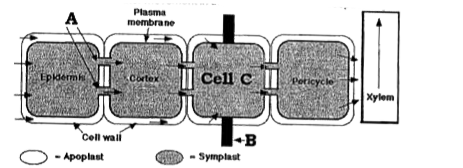Discuss the pathways by which water moves into root.
Step-by-Step Solution:
1. Introduction to Water Absorption:
- Water absorption in plants primarily occurs through the roots. The root hairs, which are tiny, hair-like structures at the tips of the roots, play a crucial role in this process by increasing the surface area available for water absorption.
2. Pathways of Water Movement:
- Once water is absorbed by the root hairs, it can move deeper into the soil and through the plant via two main pathways: the Apoplast Pathway and the Symplast Pathway.
3. Apoplast Pathway:
- The apoplast pathway consists of the system of adjacent cell walls. Water moves through the cell walls and intercellular spaces, allowing for rapid movement. This pathway is continuous throughout the plant but is interrupted by the Casparian strip, which is found in the endodermis of the roots. The Casparian strip is a band of suberin (a waxy substance) that is impermeable to water, thus forcing water to enter the symplast pathway at this point.
4. Symplast Pathway:
- The symplast pathway involves the movement of water through the protoplasts (the living part of the cell) of adjacent cells. This pathway is facilitated by structures called plasmodesmata, which are microscopic channels that connect the cytoplasm of neighboring cells. Water moves from one cell to another through these connections, allowing it to bypass the cell walls.
5. Transition Between Pathways:
- Water can move through the apoplast pathway until it reaches the endodermis, where the Casparian strip is located. At this point, water must enter the symplast pathway to continue its journey into the vascular system of the plant.
6. Conclusion:
- In summary, water moves into the roots primarily through root hairs, and then it can travel deeper into the plant via two distinct pathways: the apoplast pathway (through cell walls) and the symplast pathway (through protoplasts). The presence of the Casparian strip in the endodermis is a critical factor that influences this movement.
- Water absorption in plants primarily occurs through the roots. The root hairs, which are tiny, hair-like structures at the tips of the roots, play a crucial role in this process by increasing the surface area available for water absorption.
- Once water is absorbed by the root hairs, it can move deeper into the soil and through the plant via two main pathways: the Apoplast Pathway and the Symplast Pathway.
- The apoplast pathway consists of the system of adjacent cell walls. Water moves through the cell walls and intercellular spaces, allowing for rapid movement. This pathway is continuous throughout the plant but is interrupted by the Casparian strip, which is found in the endodermis of the roots. The Casparian strip is a band of suberin (a waxy substance) that is impermeable to water, thus forcing water to enter the symplast pathway at this point.
- The symplast pathway involves the movement of water through the protoplasts (the living part of the cell) of adjacent cells. This pathway is facilitated by structures called plasmodesmata, which are microscopic channels that connect the cytoplasm of neighboring cells. Water moves from one cell to another through these connections, allowing it to bypass the cell walls.
- Water can move through the apoplast pathway until it reaches the endodermis, where the Casparian strip is located. At this point, water must enter the symplast pathway to continue its journey into the vascular system of the plant.
- In summary, water moves into the roots primarily through root hairs, and then it can travel deeper into the plant via two distinct pathways: the apoplast pathway (through cell walls) and the symplast pathway (through protoplasts). The presence of the Casparian strip in the endodermis is a critical factor that influences this movement.
Topper's Solved these Questions
- TRANSPORT IN PLANTSBOOK - MODERN PUBLICATIONCHAPTER - TRANSPORT IN PLANTSEXERCISE - REVISION EXERCISES (LONG ANSWER QUESTIONS)
10 Videos
- TRANSPORT IN PLANTSBOOK - MODERN PUBLICATIONCHAPTER - TRANSPORT IN PLANTSEXERCISE - COMPETITION FILE (MULTIPLE CHOICE QUESTIONS)
68 Videos
- TRANSPORT IN PLANTSBOOK - MODERN PUBLICATIONCHAPTER - TRANSPORT IN PLANTSEXERCISE - REVISION EXERCISES (VERY SHORT ANSWER QUESTIONS)
26 Videos
- THE LIVING WORLDBOOK - MODERN PUBLICATIONCHAPTER - THE LIVING WORLDEXERCISE - Chapter Practice Test
16 Videos
Similar Questions
Knowledge Check
The following show the pathway of water movement in the root. A, B and Care respectively
 ADesmosome, Casparian strip, EndodermisBGap junction, Casparian strip, EndodermisCTight junction, Casparian strip, EndodermisDPlasmodesmata, Casparian strip, Endodermis
ADesmosome, Casparian strip, EndodermisBGap junction, Casparian strip, EndodermisCTight junction, Casparian strip, EndodermisDPlasmodesmata, Casparian strip, EndodermisThe following diagram represent the pathway of water movement in the root. Identify A, B, and C respectively
 APlasmodesmata, Casparian strip, EndodermisBTight junction, Casparian strip, EndodermisCGap junction, Casparian strip, EndodermisDDesmosome, Casparian strip, Endodermis
APlasmodesmata, Casparian strip, EndodermisBTight junction, Casparian strip, EndodermisCGap junction, Casparian strip, EndodermisDDesmosome, Casparian strip, EndodermisThe principle pathways by which water is translocated in angiosperm is
AXylem and phloem togetherBSieve tubes and members of phloemCSieve cells of phloemDXylem vessel system
Draw the anatomy of the different pathways by which water and minerals get transported in the root. Also label it.
View SolutionGiven figure shows pathway of waer movement in the root. Identify the labelled parts and select the right option about them

View SolutionCorrect pathway of water movement in plant roots is
View SolutionThe principal pathways by which water is translocated in angiosperms is
View SolutionThe principal pathways by which water is translocated in angiosperms is
View Solution
